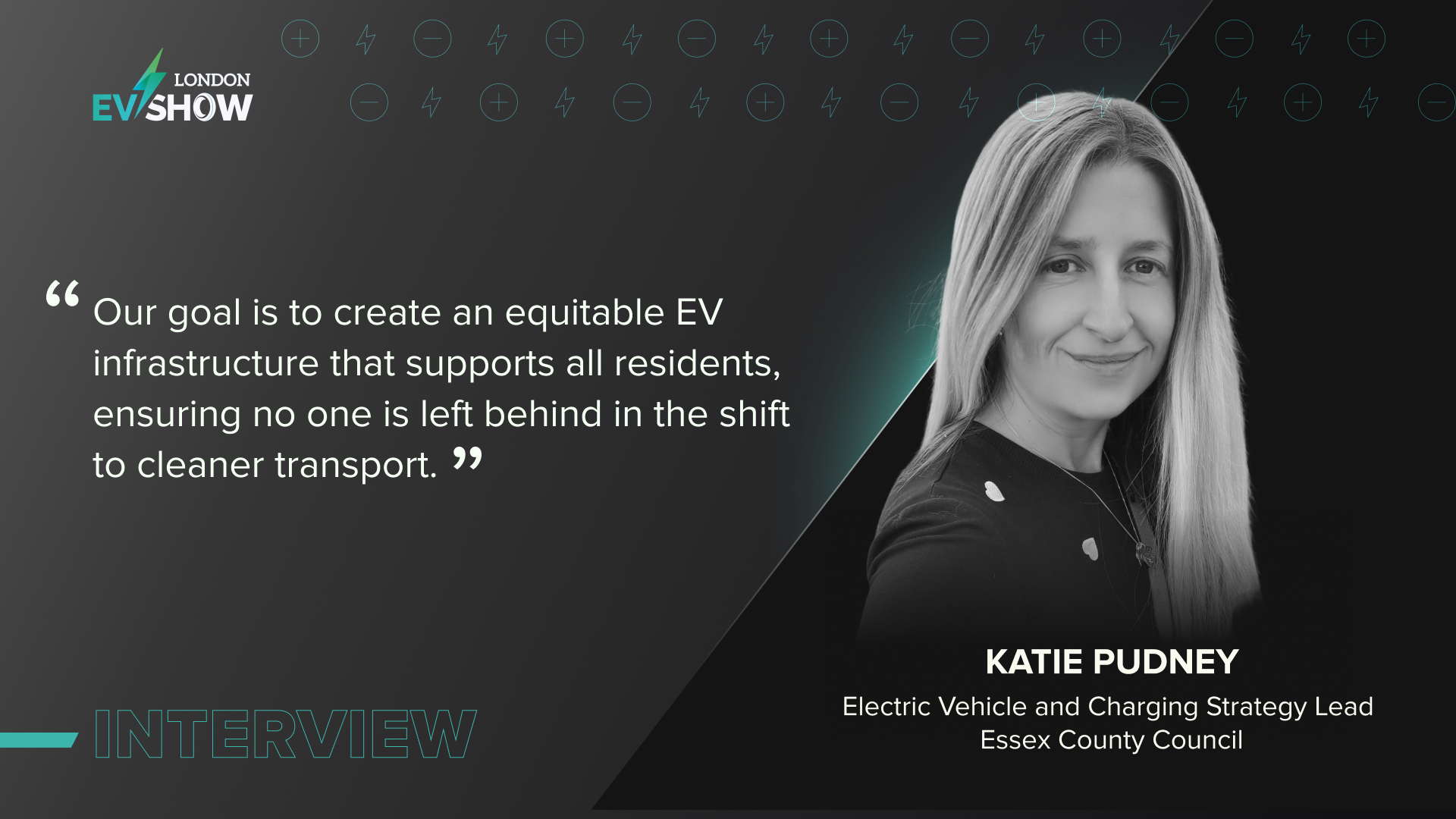Katie Pudney, Electric Vehicle and Charging Strategy Lead at Essex County Council, joined Ambreen Mir for an insightful Q&A session, sharing her extensive experience in delivering EV infrastructure at the local authority level. She discussed the phased approach Essex has adopted for installing public chargers, the challenges of adapting existing systems, and the critical need for equitable access to EV infrastructure. Katie highlighted how initiatives like ORCS and LEVI have been instrumental in securing over £8.5 million in funding to deliver more than 5,000 public charging points by 2031. She also reflected on the importance of community engagement, collaboration with partners, and how events like the London EV Show are key to driving innovation and progress in the EV sector.
#Ambreen: What are some of the key challenges you've faced in delivering EV infrastructure at the local authority level, particularly through schemes like ORCS? How are you addressing these hurdles?
#Katie: Charging point installations can be very tricky: a lot of thought and preparation goes into the process. At Essex we have developed a three-phase process:
- Site identification
- Site Assessment
- Installation
Every stage is multifaceted, which means that locations are heavily subject to change and challenges right up until the point they are installed on the ground. Once a site is selected and assessed to ensure it meets our criteria, we then work with our chosen provider to check the site is viable for installation, undertake road safety assessments, secure the necessary licences and permits, change or introduce traffic regulation orders (if required) and engage with nearby residents regarding planned installations. Time is possibly the key challenge throughout, because some parts of the process can not be run concurrently so we must wait for these to be completed before moving on to the next.
EV charging installations for most local authorities are a relatively new thing. And some of our processes and systems were not set up for the delivery of charging points, so these have had to be introduced, adapted or changed. We have also had to change locations for various reasons, including unworkable point of connection costs, issues brought forward through road safety assessments and resident push back. Each time, we must go back to the beginning of the process to find another suitable site.
#Ambreen: In your view, what does “the right charger in the right place” truly mean when planning public EV infrastructure? How do you balance strategic planning with community needs?
#Katie: A key component of Essex’s transition to electric vehicles (EVs) is that they are not seen as the silver bullet for achieving targets on transport decarbonisation. A switch to EVs can contribute to improving air quality and achieving our net zero goals. Although only part of the solution, EVs have a key role to play, alongside our work to encourage sustainable transport options, such as walking, cycling and bus travel. So, our EV charging network must support a sustainable switch to EVs without encouraging unnecessary vehicular use.
Equally, we are aware, for various reasons, that some residents can make the shift to EVs more easily than others. This is certainly not the case for 36% of Essex households who do not have access to off-street parking and find it harder to charge a vehicle at or near to their homes and at prices equivalent or near to that of a domestic energy supply. Furthermore, and typically, residents who live in properties without off-street parking have a lower household income than those who do have off-street parking. There is therefore a social equality element to making the switch. As a local authority, we must ensure the distribution of charging points is equal, using public funding, where available, to bridge any gaps in the network and make less commercially lucrative sites more viable.
#Ambreen: Looking ahead, how does your team envision EVs contributing to broader net-zero goals, and what role will upcoming initiatives like LEVI play in accelerating this transition?
#Katie: EVs will play a substantial role in Essex’s commitment to become net-zero by 2050. However, as noted above, it is just one piece of the puzzle. An EV is still a vehicle and contributes to congestion thus replacing a noisy traffic jam with a silent one. The financial cost of congestion is also considerable for the government, businesses and individuals. Less private vehicular travel is the most effective way to reduce transport emissions, but where vehicular journeys are necessary, then these need to switch to being zero emission, where possible.
One of the most cited reasons why people cannot make the switch to EVs is the lack of public charging infrastructure, and near home infrastructure which provides the convenience of charging vehicles overnight. EV users need the confidence that they can charge their vehicles easily, and cost effectively, via a reliable, available, accessible, and safe network. Unfortunately, local authorities do not have the budgets to be able to deliver the networks they need, but opportunities like the On-Street Residential Charging Point (ORCS) and the Local Electric Vehicle Infrastructure funds (LEVI) make it a lot easier to deliver much needed residential charging infrastructure and attract additional private investment. Without this funding, we almost certainly would not be able to achieve our target of having at least 6,000 charging points across Essex by 2030.
#Ambreen: Could you share insights into how you're engaging with residents, businesses, and other local authorities to shape a more inclusive and efficient EV ecosystem? Are there any specific learnings from partnerships with CPOs or other councils?
#Katie: The beauty of this industry is that we are all trying to enable a sustainable shift towards EVs by meeting the current and future charging demands of the country. Working closely with other local authorities who are at different stages in their strategies has enabled us to learn from one another and to share our experiences. This collaboration has fed into our ORCS and LEVI projects and has been extremely helpful in helping us to develop effective and efficient EV infrastructure projects for the county.
We are also working closely with our 12 city, district and borough partners who feed into our strategy’s development and action plan and offer invaluable localised knowledge on potential charging point locations, so we can make more informed decisions. As part of our LEVI project, we will be working closely with our partners, as well as our Parish Council partners to identify both on-street and off-street locations for charging points.
We are currently developing a broader engagement strategy so we can reach out to more residents and businesses. We want to engage with as many residents and businesses as we can, and we are keen to hear any suggestions for charging point locations via our website. We are using demand led tools to identify areas of need, however we feel the knowledge of residents and businesses is unrivalled in ensuring we deliver the network Essex needs.
Working with Charging Point Operators (CPOs) has also provided incredible opportunities to see and understand charging infrastructure delivery from a completely different angle. The work that goes into charging point delivery from both sides is bigger than I ever comprehended. This has enabled us to provide more accurate timescales and manage expectations on delivery. I think it also helps for CPOs to understand the processes of local authorities, so together, we can deliver projects which bring many benefits for the county and for the CPO.
#Ambreen: As the London EV Show marks its 5th edition this year, how do you see events like this supporting the wider EV landscape, and what are your key priorities moving forward—especially in areas like buses, heavy vehicles, and taxi electrification?
#Katie: Events like the London EV show offer a superb opportunity for knowledge transfer across the industry, and the chance for private and public sectors to come together and network. The industry and charging infrastructure market is developing so quickly but events like this make it easier to bring people up to date and to explore opportunities to see/trial the latest technology in person.
As we progress away from the early adopter stage and towards the early majority stage of the EV demand curve in Essex, we are starting to think about strategies and infrastructure needs for other vehicles, like heavy vehicles, buses and taxis. We are committed to supporting all industries to achieve their own targets on net zero and will be working on the second phase of our EV strategy in the second half of 2025.


